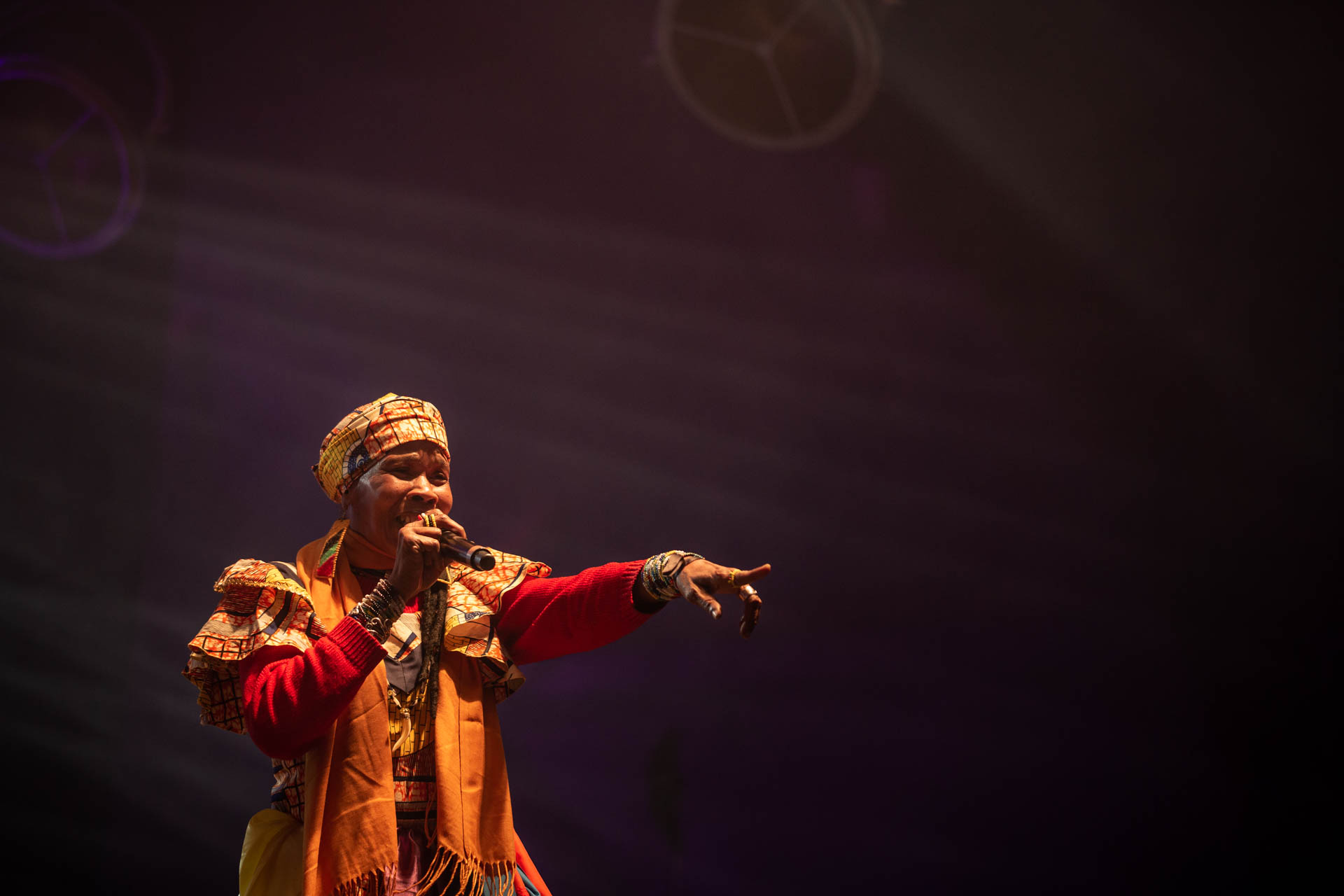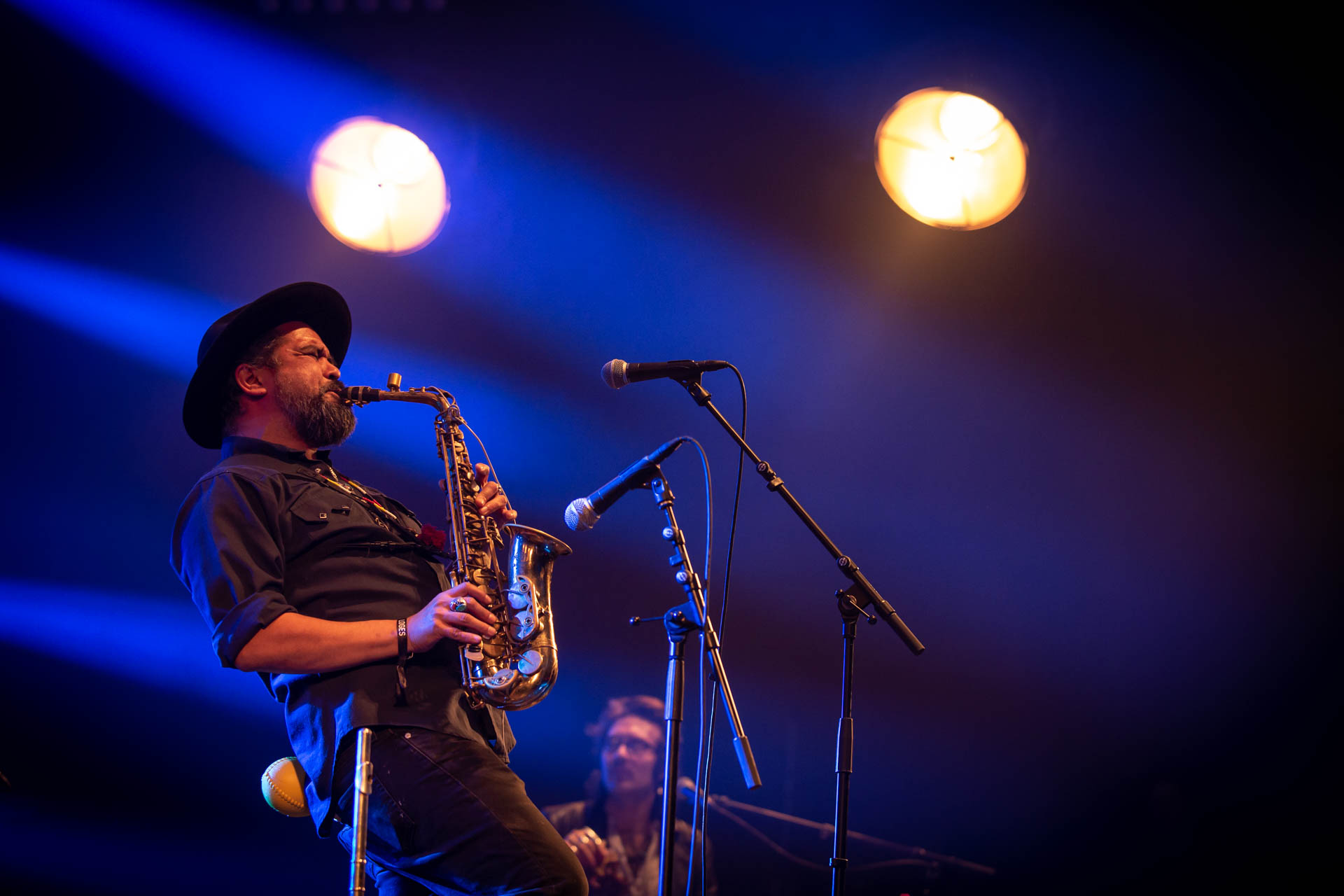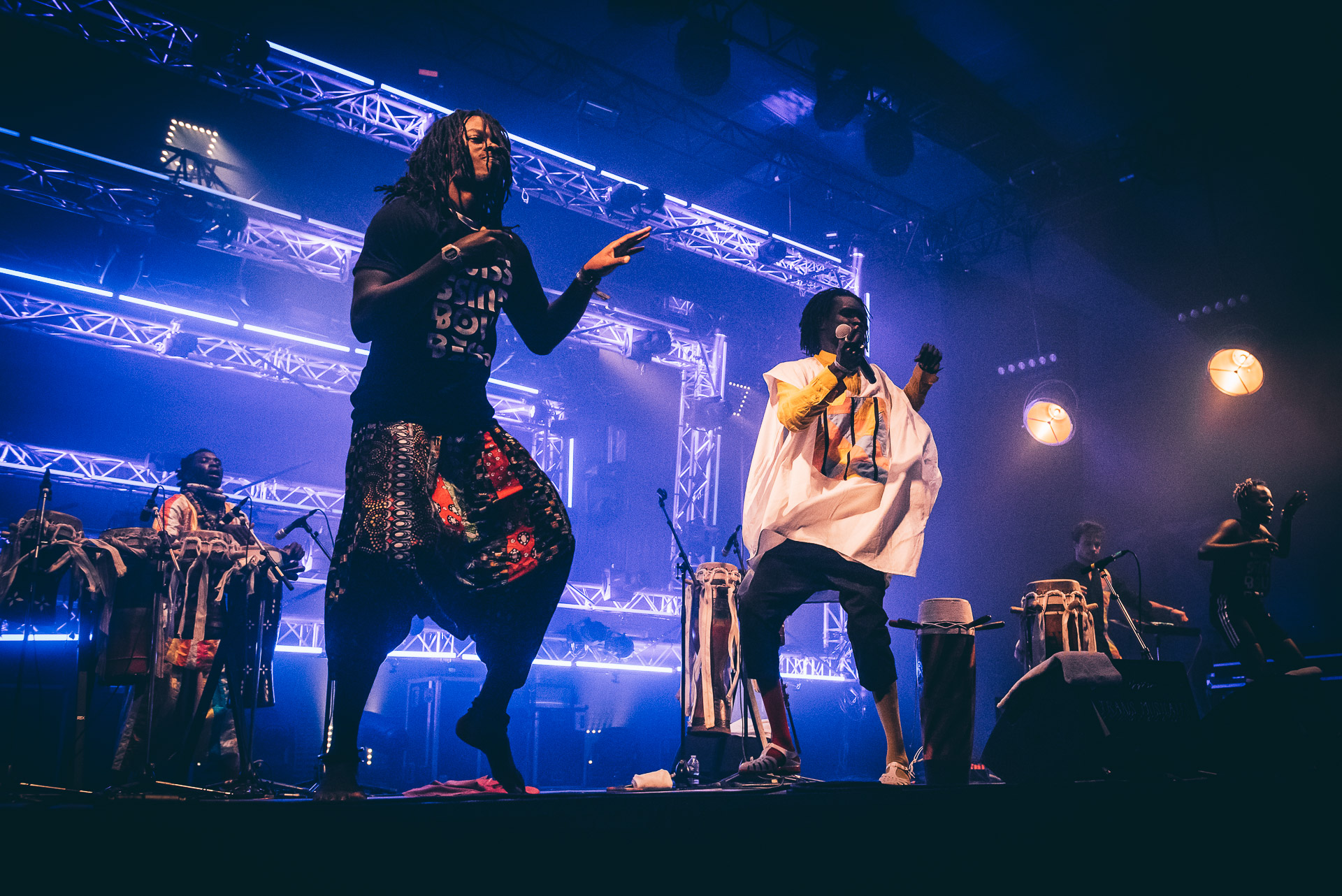
At the Transmusicales festival, “trance” is not just a word in its name. PAM accompanied artists at the festival whose music is closely linked to a phenomenon ethnomusicologist Gilbert Rouget dedicated a reference book to, Music and Trance. It became an intense experience.
Photo : Chouk Bwa & the Ångstromers © Trans Musicales / Nicolas Joubard
“Are you going to Trans’ this year?” The Rennes-based yearly festival may no longer be an insider’s secret – 56,000 people attended the 41st edition – yet the event has maintained an intimate relationship with its audience to honour its nickname. “Trans‘” creates the promise of reunion and (re)discovery, with its 84 acts with origins from as many different universes. The Breton festival continues to embody the concept of “transmusicality” by once again offering a highly eclectic lineup where genres, disciplines and boundaries – are all far from set. While the festival ended with Sylvie Kreusch’s totally hallucinating tribal pop, Acid Arab’s techno-raï and DJ Coco Em’s hot Nairobi house, the five-day gathering generated, as always, numerous altered states of consciousness.
From Siberia to Brazil, from Ethiopian zār to Benin voodoo, ethnomusicologist Gilbert Rouget identified several main types of trance in Music and Trance (University of Chicago Press, 1985; French original version: Gallimard, 1980): that arise from shamanism, possession, and communion. Their mechanism, function and relation to music differ according to the peoples and regions of the world, however all trances are defined as altered states of consciousness “that are obtained by means of noise, agitation and in the presence of others”. And although songs, dances and drums are the common denominator of most “root” trances, it’s impossible to ignore their somewhat “profane” transmutations in the wide range of modern music – techno, first and foremost. Intrigued by the inexhaustible energy of sweaty bodies on the Breton dancefloor, PAM experienced Trans’ through the prism of trance. It got Intense.
Chouk Bwa & The Ångstromers’ possession trance #1
Following Se Nou Ki La, a notable debut album released in 2015, Chouk Bwa has made a successful comeback (a new record is expected next spring) alongside The Ångstromers – a Belgian duo whose modular synths deliver mystical textures more suited to the Haitians’ repertoire, composed of voodoo-like rhythms and incantations as well as protest songs. “I’m not going to tell you about my voodoo initiation, it’s a sacred thing,” announces Edele immediately, a very charismatic backing vocalist and dancer in Chouk Bwa & The Ångstromers. The rest however, she will talk about.
Edele is a mambo, an initiated “priestess” who leads the ceremonies and interprets the wills of the Lwas, voodoo spirits who crossed the Atlantic Ocean with slaves from Dahomey in the 16th century. In the voodoo cults, the trance is about possession, i.e. a trance where the followers, led by chants, dances and powerful rhythms of the drums, invite their own Lwa to express through themselves. Each initiated member addresses their Lwa according to specific rhythms, chants and dances. Edele’s Lwa name is “Jati Bwa”. Her dance is lively, feline, and quite obviously entranced. “A talented drummer can easily induce possessions as well as stop them,” wrote Alfred Métraux in Voodoo in Haiti (Pantheon, 1989; French original version: Gallimard, 1958). Edele confirms: “When I’m on stage with Chouk Bwa, I always ask the musicians not to play the rhythm of Jati Bwa, because otherwise I enter a trance and I don’t remember anything,” she explains, confirming what Gilbert Rouget spoke of when he evoked the amnesia of the possessed person. It’s serious stuff! Although Chouk Bwa’s repertoire does not contain “proper” trance calls, songs such as “Vodou Alé” and “Nago” are indeed based on ceremonial rhythms whilst the amazing vocalist Sambaton Dorvil rings the sacred bell, called the ogan.
“Vodou is the cult of love and sharing, it is healing music. Even when an initiated member is violently punished by a spirit, people take care of him. You have to stop with this whole ‘voodollywood’ stuff!”, gently exclaims Nicolas Esterle, the Ångstromers’ least bearded member – for now.
Completely immersed in voodoo culture after having experienced several ceremonies at the Gonaïves, Haiti – home of Chouk Bwa’s members – the two European musicians materialize the presence of Lwas on stage with their modular synthesizers and “electro-acoustic processes that can also be found in dub music, like reverb and delay. But hey, the Lwas are among us anyway!” they add, laughing. These Haitian voodoo spirits here meet those of Jacques Roumain and Toussaint Louverture, leader of the slave revolt in the Haitian Revolution that led to the country’s independence on January 1st, 1804. “Voodoo in Haiti is all that remains: it is our culture that makes us stand up,” concludes Edele without telling much more about the current socio-economic tensions that the island has experienced recently. Before leaving, she covers my face with delicately scented ritual ointment and pulls on the bridge of my nose. Was this the beginning of an initiation?
Cochemea’s shamanic trance
https://www.youtube.com/watch?v=JhjuPs_6xPA
Contrary to the trance of possession in which the initiated person invites a spirit into their body – “a visit is received” – in the shamanic trance, according to Gilbert Rouget, “a journey is taken” towards the world of the spirits so one can understand the needs of the community. For American saxophonist Cochemea Gastelum, it seems that the world today needs unity, peace, love and harmony between all forms of life. This is what can be heard in All My Relations, his second solo album released in 2019 on Daptone Records, and whose title quotes a Lakota prayer – from a Native American tribe. After playing with Sharon Jones, Public Enemy, Archie Shepp, David Byrne and Amy Winehouse, Cochemea decided to reconnect with his spirituality, his roots and his Native American ancestors. “Music seemed to be the perfect vehicle for that purpose,” he prompted while distractedly caressing a huge turquoise ring.
“I am Yaqui [or Hiaki or Yoeme, an indigenous people of Northern Mexico; editor’s note] by my father but he died when I was a child. I have long been cut off from my native ancestry,” continues the man whose name literally means “they were killed in their sleep”. Cochemea then grew up with his mother, surrounded by the music of Alice Coltrane and Charlie Parker, however she passed down to him “some values, and intuition”. But it’s when he finally reconnected with his father’s side that he discovered, amazingly, a family of urban Native Americans living in Southern California! Cochemea then entered the world of pow wows (Native American gatherings), and came to learn that he descends from a long line of musicians and began to devour the texts of Vine Deloria and has since shaped a strong taste for Native political concepts. And the election of Donald Trump, in 2016, did not make things any better.

Cochemea © Trans Musicales / Nicolas Joubard
Relying on the ritual practices of both the Tungusic people of Siberia and the Eskimos, Gilbert Rouget described the shamanic trance as follows: “to the sound of drums and songs, the shaman – or rather his soul – leaves his body in order to travel to the invisible world and meet its inhabitants [dead people or spirits].” The initial idea with All My Relations? Record an album where percussion would be central, entering a dialogue with the incantations of the choir and Cochemea’s saxophone, in order to allow his imagination to “return to places where I have never been, connect with the spirits of my people and try to heal the world a little, in my own way”. With “Sonora” – named after the North-Mexican state where some of the Yaqui people live –, Cochemea enters the land of his ancestors; “Maso Ye’eme” means “the dancing deer”, a sacred and highly spiritual figure for the Yaquis; and “Mitote”, inspired by a circle dance of the Nayarit warriors. Composed on the formation of a collective improvisation “looking much like a ritual ceremony” – with ten musicians in the same studio for 24 hours – the record testifies, as does the performance at Transmusicales, a deep communion. “I felt like I was slipping away more than once in the studio,” Cochemea said, finger-drumming the rhythm on the table in front of him. ”This record bears the marks of a long journey. In a way, it signifies the end of my spiritual journey.”
Go Go Machine Orchestra’s communal trance
At the heart of the Sufi practices is the dikhr, known as khalwa in Senegal: a trance less spectacular than the trance of possession, but just as connected to the divine in its quest for communion. By calling out and repeating the name of God along to the rhythm, the initiated members open a channel in their hearts – now ”free of earthly concerns” – to better approach God and reach fana, a contemplation level in a state of bliss. When the practice is collective, the dikhr is hypnotic and leads to trance.
Similarly, but on a non-belief level in this case, Go Go Machine Orchestra turn repetitive minimalist music into their communal mantra. Admirers of Steve Reich, Philip Glass, techno loops and ethereal movie soundtracks, the members of Go Go Machine Orchestra have a relationship with sound based on the concept of “lessness”. “The less effects or notes you create, the more creative you become and the more room you create for meditation,” says Bai-Hsun Chung, a musician so wonderful to watch behind his modular synth – and in front of an astonishingly attentive audience, considering the late hour, reactive to this progressive, luminous and instrumentally fluid assembly.“When I play our music, I am carried away by the repetition of patterns and then I slip away. I feel alone on the planet, empty yet full at the same time,” says pianist Ni-Li Tang, echoing the Taoist philosophy. Pin-Hsin Wang, in charge of electronic manipulation, adds, “I sometimes feel like I’m in the middle of the universe, powerful in my mind, with a heart wide open. As if I was turning into a channel.” A dissociated state that would surely have sparked the interest of Gilbert Rouget. The Taiwan-based members of Go Go Machine are unanimous: “We have received many testimonies from people who say have been healed by our music. We believe them because it heals us too.”
By going deep into the details of listening and composing,“into the details of every single note”, the young band work hard on their textures and advocate a return to the fundamentals in a world saturated with desires. “It’s also a way of canceling time and being in the present. In fact, our music calms this entranced world,” adds marimba player Mao-Sung Lee who, without knowing it, pointed out one of the contradictions raised by Gilbert Rouget. Sometimes the music triggers the trance, and sometimes it soothes it. According to the political textbook Dao De Jing, non-action promotes the growth of nature and while none of the members of the Go Go Machine Orchestra directly practice Taoism or Buddhism, the relationship to these concepts, even on a “secular” level, is assumed. “Moreover, we want to include Chinese percussion in our music in the future, like these very small cymbals whose sound is ageless,” they add.
It’s a wonder why ecstatic plenitude, a form of communion with the divine, is not the next step for these young creative minds, adherent to silences and “lessness”. Because if we believe Rouget, this state of “ravishment [can only be] attained with silence, solitude and immobility”. As wise as they might be, the members of the Go Go Orchestra do not look like they want to keep quiet for now: they recently released TIME, an encouragingly received debut album. The journey continues.

Guiss Guiss Bou Bess © Nico M
Guiss Guiss Bou Bess’s possession trance #2
For Guiss Guiss Bou Bess, the trance of possession is expressed by the polyrhythm of the sabar, the mystical drum of the Lébou community in Senegal. The mechanism is much the same as the Haitian voodoo trance: chants, dances and drums accompany the initiated person until they fall to the ground, possessed by their rab, and they eventually exclaim the name of the spirit. In the sabar, the initiated person reaches the trance through a dedicated rhythm: the ndöp. Each year, it gives rise to splendid ceremonies in Cape Manuel, Senegal, where all the women, dressed in white, purify themselves through a ritual bath in the ocean, while offering sacrifices to Leuk Ndao Mbaye, the protective spirit of Dakar. For the Transmusicales festival in France, Guiss Guiss Bou Bess (“new vision” in Wolof language) performed Set Sela the very day of its release, a debut album that revisits the traditional sabar with the electronic textures of beatmaker Stéphane Costantini. Including the ndöp, with the song “Ndup”.
The voice of Guiss Guiss Bou Bess is Mara Seck, coming to fruition from a family of griots and also as the son of Alla Seck, tassu singer, dancer and ambiancer for Youssou N’Dour. ”I grew up in the sabar and I was almost born with the ndöp. I have accompanied many ceremonies,” he tells us. “ ‘Ndup’ is a song that takes me away far into the air. Sometimes, we do not perform it live because it conveys too much energy.” On this subject, ethnomusicologist Gilbert Rouget evokes “the trance of the musicants” as being a very rare situation. At one point in the concert, Mara Seck goes to the front of the stage and places a long and slender drum on his shoulder, the nder. This is the conductor’s drum, that of the soloists. “By doing this, I am calling the spirits. I play their notes, they come and give me a lot of strength. But I have to adjust the intensity because it can be dangerous: imagine if I make someone faint during a concert?”, he prompts, very seriously. On the machines, Stéphane Costantini embraces the rhythm of the ndöp, “following the ebb and flow of the percussion in its crescendo, up to the climax.”
In sabar, dance is another fundamental element of trance. On stage, Mara Seck dances the ndöp. In his initiative to modernise the sabar with club-tailored beats, Guiss Guiss Bou Bess has also renewed his choreographic vocabulary by adopting the krump: “the hip-hop of the possessed!” cheekily adds Stéphane Costantini.
Mara Seck also confesses that he’s been away from the ndöp ceremonies for a few years: “because it’s too crazy when the mind is too dark.” That’s why, in the darkness of the soundcheck, you can hear him sing religious incantations from the Baye Fall – another Senegalese mystical community to which Guiss Guiss Bou Bess paid tribute on “Lamp”. Why ? “To call in the light.”


